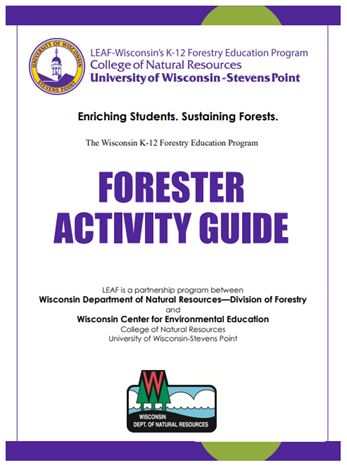In 2008, LEAF, Wisconsin’s K-12 Forestry Education Program, created a Forester Activity Guide. The intent of the guide was to help foresters lead age-appropriate, interactive, hands-on classroom programs for students in grades K-8 with a minimum amount of advanced preparation. The guide was promoted to foresters throughout Wisconsin and even included as part of programming during new forester orientation.

Front page of the Forester Activity Guide. Credit: LEAF
In fall 2021, LEAF staff, working with Kirsten Held, determined that an update to the guide was overdue. To be certain a new guide would meet the needs of current foresters, LEAF sought input from professionals around the state who have both field experience and an enthusiasm for working with students.
The following DNR Division of Forestry staff partnered with LEAF to create a new and improved Forester Activity Guide: Brooke Ludwig, Eau Claire; Steven Kaufman, Oconto Falls; Kara Oikarinen, Washburn; Scott Mueller, Medford; Sarah Ward, Montello; and Brian Wahl, Fitchburg.
The new Forester Activity Guide builds upon the goals set for the original K-8 guide by including more opportunities for outdoor learning around themes that foresters are frequently asked about: What Do Foresters Do?; Caring for the Forest; Forest Products & Benefits, Tree Planting and Natural Restoration and Fire.
All activities include tips for modifying lessons to urban settings and suggestions on how to use the lessons with learners from grades K-12. Lessons in the new guide all have slideshow presentations that foresters can use if their visits must take place in an indoor setting and require even less advanced preparation than lessons for the original guide.
The Forester Activity Guide can be downloaded and printed from the LEAF Website. When visiting the website, there is the option to download the complete activity guide or just the materials needed for any one of the guide’s five themes: What Do Foresters Do?, Caring for the Forest, Forest Products / Benefits, Tree Planting & Natural Restoration and Fire.
The main lessons and activities are similar to a script. They describe what and how one should complete the lessons and activities and even give suggestions on what to say and questions to ask. Prior to each event, the forester will want to take time to review the entire lesson and determine which aspects will work best with their audience – and even make notes/reminders to help on the day of the presentation. Many lessons have multiple options to consider and are not intended for the entire lesson to be used in one visit. Each lesson will conclude with a review of the key messages which link back to the primary and secondary objectives.
Following the lesson, a forester can find a combination of optional activities related to the theme, links to videos or other materials that can be used, recommended LEAF teacher resources to support the theme, and print resources that are needed for activities in the theme. The foresters and LEAF staff have covered all the bases in preparing materials that are both effective and efficient for all to use.
Contents of this article are shared for informational purposes only. The Wisconsin Department of Natural Resources does not endorse and makes no representations, expressed, inferred or implied, concerning these organizations, programs or services.
